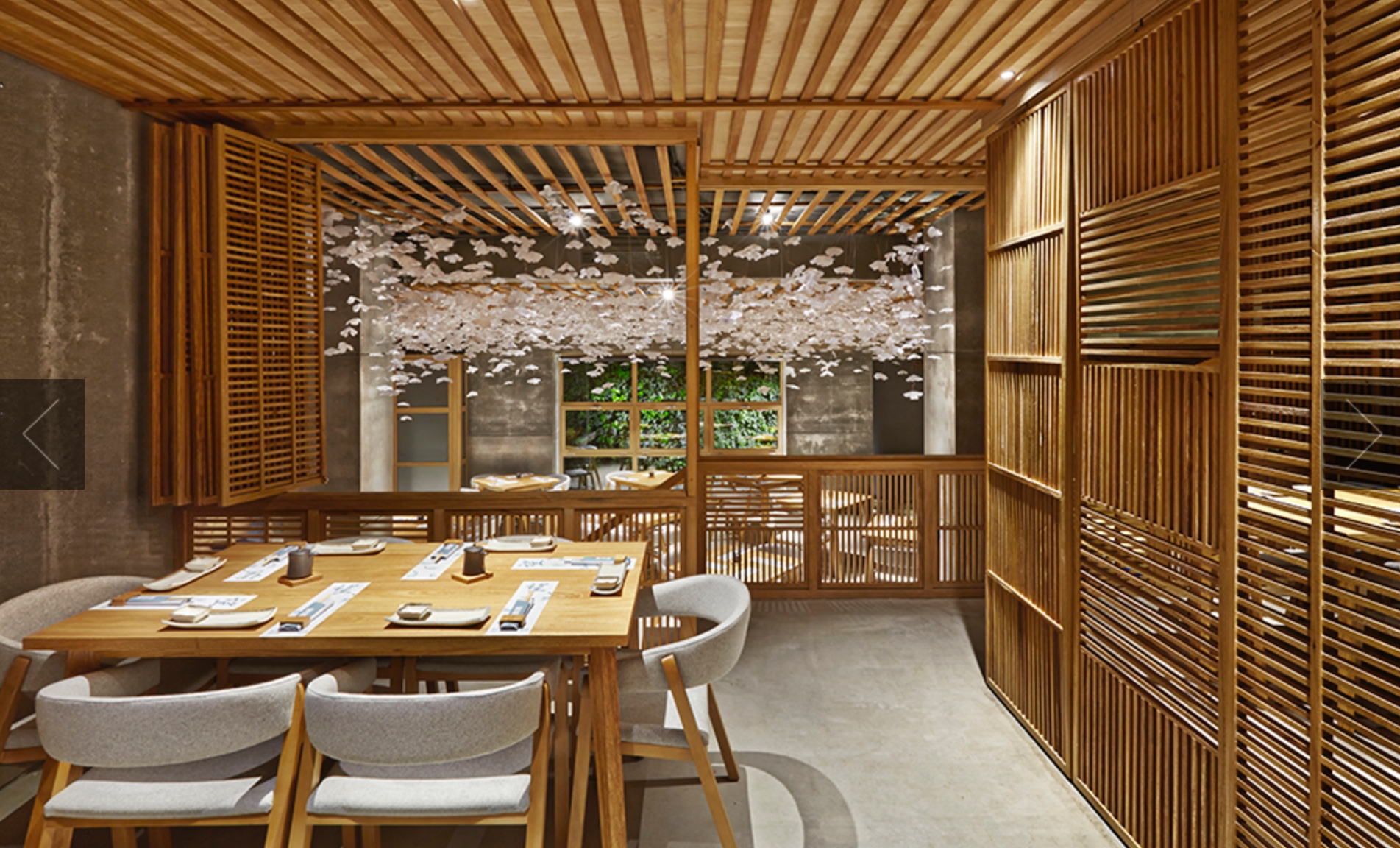Contract Design Magazine Ι April 3, 2015
Nozomi, a sushi bar in the Spanish city of Valencia, combines eras of Japanese architecture both beloved and shunned. In the foreground is rich, warm Japanese woodwork, screens, lattices, and delicate ceiling beams harkening to Japan’s 17th century and further in the past. In the background, stark concrete floor and walls recall an extremely rational midcentury modern Japan, perhaps even military spaces.
With the 2,500-square-foot Nozomi, design firm Masquespacio reconsiders these two design traditions as elements of Japanese history. Valencia-based Masquespacio—led by Ana Milena Hernández Palacios and Christophe Penasse—is focused on branding and interiors. They began this project with an intensive study of Japanese culture and the origin of sushi, and focused on the duality of the two eras of history.
From the restaurant’s wooden pitched-roof entrance, which recesses into a concrete wall, diners walk past a discrete wooden structure—a freestanding, pitched-roof building within a building that contains restrooms and storage—in the center of the restaurant. This entrance sequence is the first cue to the project’s overriding atmosphere—an outdoor Japanese streetscape. Corridors are akin to a narrow medieval Japanese street before opening into the airy main dining room. This rhythm of narrow streets opening into courtyard-like open space is inspired by the 400-year-old Gion neighborhood of Kyoto—the city’s historic Geisha district—an international symbol of pre-war Japan. Kyoto is also a frequent travel destination for Nozomi proprietors José Miguel Herrera and Nuria Morell. Framed receipts from their travels to Japan hang on the Nozomi restroom walls.
This emphasis on creating an informal streetscape atmosphere unites two very different culinary traditions—the Japanese sushi peddler and the venerable Spanish tapas bar—in which conversation and activity spills out onto the street. “We wanted to have the essence of a bar in the street,” says Masquespacio founder and Creative Director Ana Milena Hernández.
Detailed design from custom woodwork to branding
The sensation of entering outdoor space is accentuated by the main dining room’s flat ceiling covered in white fabric cherry blossoms—a suspended, fluffy cloud over diners that obscures the exact height of the room. With no clearly visible limit to the ceiling plane, diners’ imaginations can drift upward. “You feel [like you are] outdoors, but you’re inside,” says Herrera.
With the fabric flowers as the primary purely decorative element in an interior with concrete walls, Nozomi’s presentation of details is minimalist and almost austere. Hernández says this approach was taken to draw attention to the craftsmanship of wood, which is mostly blond Brazilian and European oak. Movable wood screens easily divide smaller dining rooms and define window openings into the main dining area. The screens alter their orientation both horizontally and vertically, and the custom woodwork has varied patterns and textures for a handcrafted ambiance—an enigmatic contrast to the gray anonymity of the concrete walls. “The details of the carpentry are those that should be in the spotlight,” Hernández says. “That’s the way the design is minimalist, but it still contains many details and imperfections.”
Herrera and Morell wanted a traditional presentation of Japanese design elements for their restaurant, in which an open kitchen at the rear of the main dining room allows all to see Nozomi’s sushi chefs at work. Masquespacio’s design also recontextualizes traditional Asian design with modern forms and materials in a way that separates these familiar and timeworn tropes away from stereotypical clichés. “We don’t like to appeal to common topics in our projects,” Hernández says. “If we appeal to them, we try to reinterpret them.”
In a comprehensive approach, Masquespacio also designed the complete brand identity for the restaurant, including logos for all place setting elements, menus, chopstick holders, and even the owners’ business cards. An illustration of Koi fish, a symbol of good luck and perseverance in Japanese culture, is seen on menus and other place setting elements. Masquespacio also commissioned calligraphy in the Japanese writing style hiragana for the brand identity.
The Spanish designers effectively infuse Japanese sensibilities and blend two distinct time periods. The restaurant is thoroughly Japanese. “In this case,” Hernández says, “the project gave us the opportunity to tell our own history and vision of Japan.
Nozomi Sushi Bar
Interior designer: Masquespacio
Client: Nozomi Sushi Bar
Where: Valencia, Spain
What: 2,500 square feet on one floor
Cost/sf: Withheld at client’s request
